Last updated on August 1, 2022
The following is an amended form of the Daily Contrarian briefing from June 30. This briefing and accompanying podcast are released to premium subscribers each market day morning by 0700. To subscribe, visit our Substack.
It’s been a tough six months — worth first half of the year since 1970 — but at least now you know what a bear market looks like.
If this period has showed us anything, it’s how quickly and violently the consensus can shift — and with no real warning, either. At the start of the year very few were predicting a bear market. Now, the bears certainly look vindicated. On the bright side, as annoying as permabears are they are nowhere near as bad as the crypto cult. At least it’s somewhat entertaining watching the bitcoin bros spin their denial.
As for the economy, nobody knows how much more pain is ahead, or indeed if the damage is even contained. What’s clear is we have persistently high inflation for the first time in more than a generation. This has given the Federal Reserve no choice but to stomp on the gas pedal where interest rates are concerned — even if it triggers a recession. Fed Chair Jerome Powell even said as much in public comments yesterday.

This puts us on a familiar collision course: when tighter monetary policy meets growth, monetary policy (the Fed) wins. That’s how it was in 2000/01, the last time we had a venture capital bubble. The only difference is how quickly interest rates upset the whole apple cart. Alan Greenspan needed to raise several times to prick the bubble. This time, tech started melting down before the Fed even touched the dial.
The labor market is still quite healthy, but that can be a lagging indicator. As liquidity washes out of the system, it brings down companies that are not well capitalized or are backed by growth capital. Investors cash in their chips and a cycle of blood-letting begins. That’s when you see firms going out of business and layoffs and the like. Then the unemployment rate rises and economic contraction sets in.
This doesn’t have to come to pass of course. There are any number of scenarios for how we can avoid it — including several provided on the most recent episode of this very podcast. Whatever your thoughts on this, remember to do your own research and make your own decisions. (Also nothing here is intended as investment advice, but you already knew that).
